Enrollment Cycle Times Can and Should Be Optimized
Applied Clinical Trials
Case study demonstrates that site activation is a key driver in determining patient enrollment cycle time.

Planning clinical trials is challenging. A significant portion of clinical trials cost more than $100 million each and last several years. By any standard, this is a major capital investment, requiring extensive planning. The complexity of conducting a clinical study is not only reflected by a huge number of variables from the operations management point of view, but also the fundamental reality that clinical trials are medical and scientific experiments. The questions for a clinical trial planner to answer are often in conjunction with those in operations management and medical development.
While clinical trial planning has been a weak spot for our industry, it is encouraging that many leaders have recognized the importance of planning properly, evidenced by the creation of dedicated clinical trial planning groups, often known as feasibility groups. However, there has been limited progress: delays are still a chronic symptom, costs are ballooning, and rescue missions are a regular part of the trial process. The challenges facing clinical trial planners remain the lack of data and, more importantly, the lack of a platform to interpret the data.
We recognized that there was no easy fix to these challenges. Over the past 10 years, along with building an extensive and dynamic clinical

development database, a set of innovative and coherent concepts has been created to help us to interpret the data, to enable us to effectively plan clinical trials.1, 2, 3, 4, 5
In this article, we use a hematology clinical trial as an example to illustrate how the PhESi clinical trial planning platform was utilized to aid the clinical trial team and facilitate the communication between the team and key stakeholders, namely the senior management.
The study team faced a familiar scenario: a promising drug candidate, high expectations, demanding timelines, and limited indication experience. This hematological clinical trial would be the first, large-scale, randomized clinical trial for this indication.
Methods
The PhESi platform takes an integrated approach in clinical trial planning. We assess the competitor landscape, including where and when the planned clinical trial will be conducted. Business processes, especially site activation processes,3 are examined in multiple dimensions. Trial design, specifically patient inclusion/exclusion criteria, is comparatively analyzed against similar trials conducted by the industry, by focusing on how these design elements can potentially impact planning parameters and operational deliverables. Last but not least, all the participating investigator sites in relevant clinical trials are assessed by going through a series of proprietary algorithms and statistical models.2,4 Those that pass this vigorous selection process are provided to the team as site candidates for the trial being planned.
It is important to emphasize that while our analysis is structured and systematic, not all the detailed results are presented to the team. We focus on providing a set of actionable recommendations the team can act on, substantiated by our analysis, and specific to the particular clinical trial being planned.
Briefly, the team was asked to conduct a hematology clinical trial, targeting enrollment of 292 patients. The sponsor was hoping to complete enrollment in 22 months.
There was a limited number of randomized clinical trials similar to our hematology trial. Simply using historical data for our planning was not possible. Extensive historical clinical trial data analysis has revealed that there is a reliable pattern between number of investigator sites (N) being deployed in a clinical trial, and gross site enrollment rate (GSER, defined as the number of patients per site per month). That pattern, with minor modification, can be established for trials in this hematology indication:1, 5
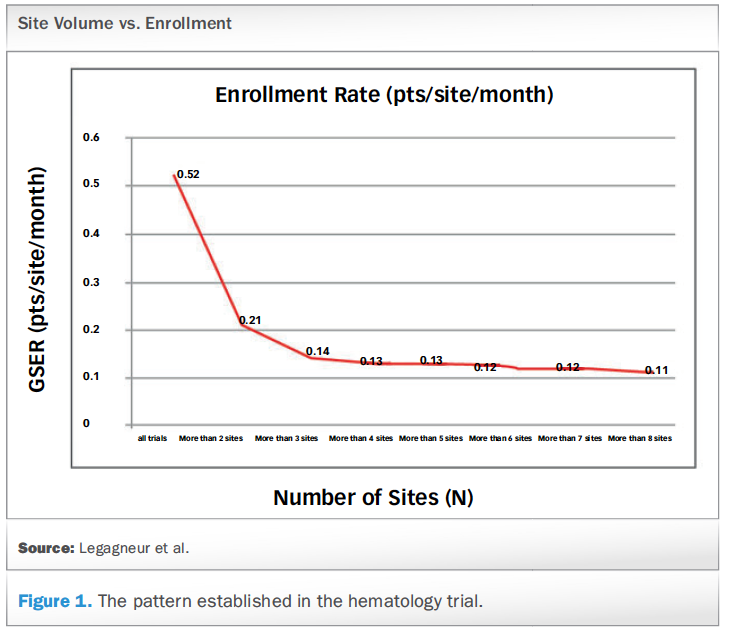
Clearly, for a trial that planned to use over 100 sites, it was not realistic to expect an enrollment rate of more than 0.11 patients per site per month. However, as a mathematical relationship can tell us, the GSER could drop below 0.10 patients per site per month, though not significantly.
The below chart summarizes the distribution of site size for clinical trials in this hematology indication completed in the past 10 years or so, as measured by the number of patients per site. It is clear that most of the hematology clinical trial sites enrolled 1-3 patients on average.
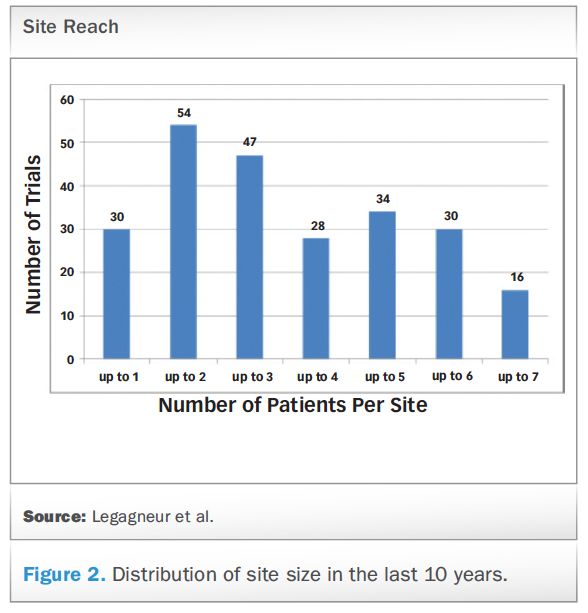
The median number of patients per site for trials is 3.0. Knowing that enrollment rate decreases as the number of sites increases, we need to add more sites than the median number of patients per site implies, which requires about 100 sites to enroll 292 patients. Considering these factors, we recommended that the team should use 120 sites, with expected enrollment of 2.4 patients per site.
One question commonly asked is whether we can proportionally reduce enrollment cycle time by proportionally adding more sites to the mix? The simple answer is no. Among many other reasons, there are operational boundaries in terms of how many sites we can activate that would contribute to enrollment. For a randomized interventional trial targeted to enroll a defined number of patients, we can expect to see an initial shortening of enrollment cycle time when adding sites. As we continue to add more sites, the benefit decreases, eventually resulting in prolonged enrollment cycle time when an excessive number of sites were added to the mix.1, 4 Empirically, we can consistently identify the optimized area (sweet spot), where an adequate number of investigator sites can help us to achieve the shortest enrollment cycle time.1,4
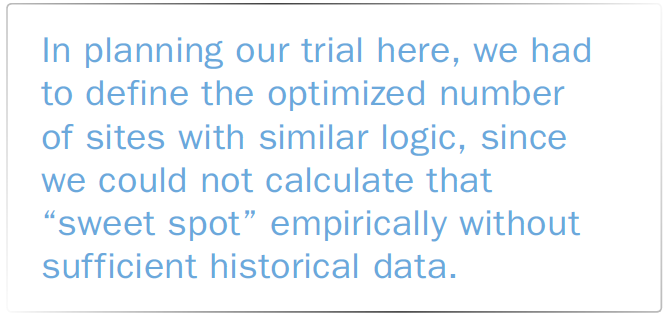
In planning our trial here, we had to define the optimized number of sites with similar logic, since we could not calculate that “sweet spot” empirically without sufficient historical data.
Now let us focus on site activation. We examined over 1,000 interventional clinical trials conducted by the sponsor of our trial with 10 or more active sites. We found that only 6% of these studies were able to activate 50 or more sites 100 days after the start date. When we focus on the trials required to activate more than 50 sites, 20% of the trials were able to activate more than 50 sites in the first 100 days. As depicted in the following chart, even if we put more resources into the larger trials that require a larger number of the sites to be activated, the percentage of trials that can activate 50 or more sites in 100 days plateaued at 25% to 27%:
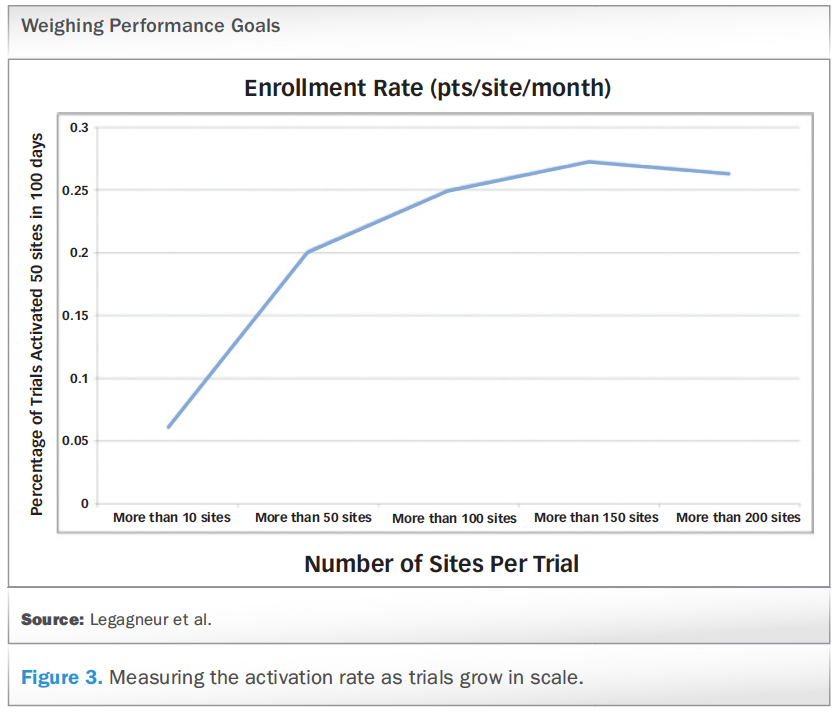
In other words, only a small percentage (~25%) of large-scale trials can activate 50 sites in 100 days-it is, therefore, an overly ambitious performance goal.
Is it feasible to enroll 292 patients in 22 months, when using 120 sites?
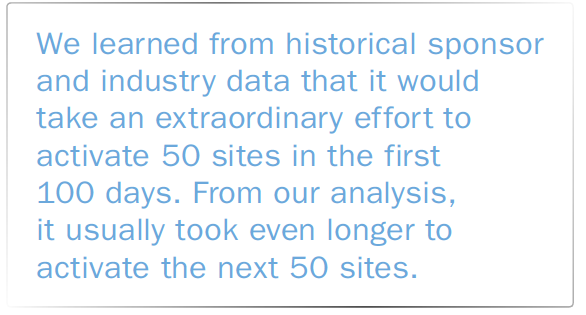
We learned from historical sponsor and industry data that it would take an extraordinary effort to activate 50 sites in the first 100 days. From our analysis, it usually took even longer to activate the next 50 sites. If everything played out to our favor, we would be able to activate 120 sites in nine months (270 days). In those nine months, we could expect to have 60 sites open and enrolling patients on average (assuming a straight site activation curve between month one and month nine). We only had 13 months to fully utilize the enrollment capacity from all the 120 activated sites. In summary, we would only be able to utilize 80% of enrollment capacity from the 120 sites deployed [(50% x 9 months + 100% x 13 months)/ 22 months]. That 80% is referred to as the Site Effectiveness Index (SEI), which measures the success of the site activation process.2, 4
This required us to enroll 0.138 patients per site per month. This enrollment rate was still 26% higher than the historical enrollment rate of these much smaller hematology clinical trials [(0.138/0.11-1)]. Neither an SEI of 80%, nor an adjusted site enrollment rate (ASER) of 0.138 patients per site per month was obtainable.
ASER, which is the GSER when we assume all the sites can be activated in day 1 of the trial. Mathematically, GSER equals to ASER times SEI. For a given protocol, ASER can be improved through a better site selection process.2,4
In order to help us to define a more realistic SEI, we examined the site activation curve of a trial with a similar indication from the same sponsor:
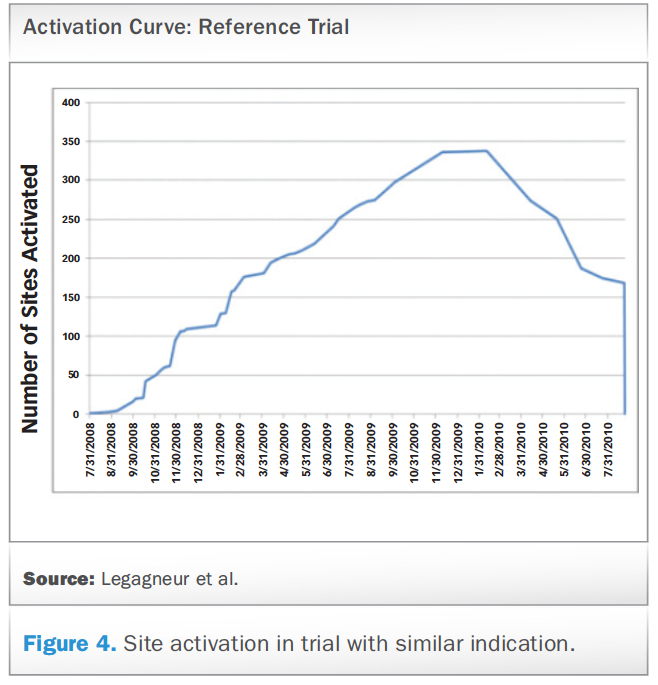
In this trial, the site activation index was 60%. This is one of the best executed site activations by this sponsor in the same therapeutic area. For an ASER of 0.11 patients per site per month, GSER is 0.067 patients per site per month (0.11x60%=0.067). This led us to recommend that the sponsor should use 120 sites to enroll 292 patients, and we forecast an enrollment cycle time of 36 months (292/(120x0.066)), instead of 22 months.
Results
The enrollment was carried out from the beginning of August 2012 to the end of March 2015, a total of 32 months. The following chart shows the actual site activation curve:
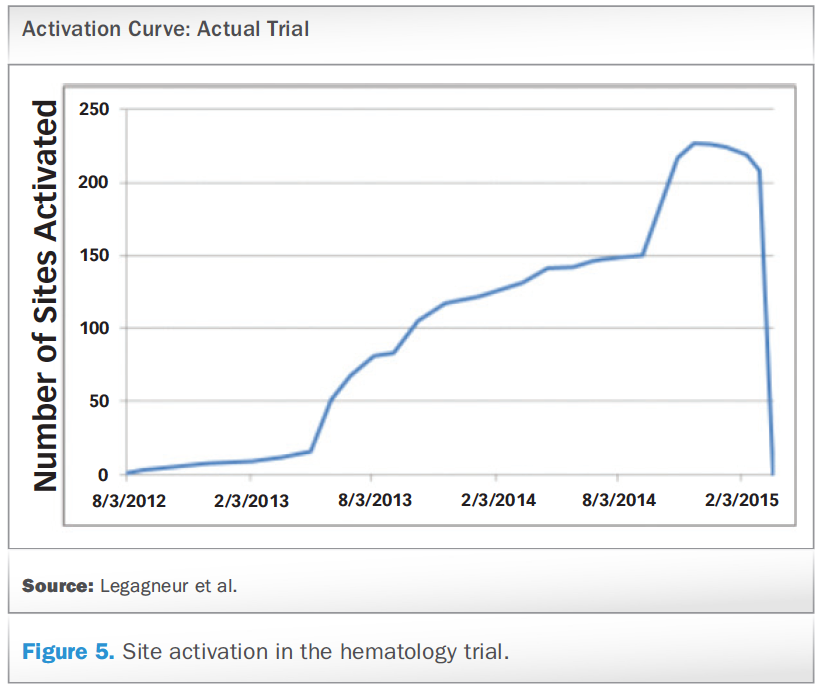
This chart helps to visualize some of the issues in the implementation of this trial. Thirty percent of sites were activated in the last six months of the enrollment period. For that reason, the enrollment contribution from those 77 sites was very limited, leading to the majority of those sites being nonperforming sites.
While we recommended using 120 sites for the trial, the team actually activated 227 sites instead. However, when we examine the results closely, there were only about 140 sites that contributed patients, much closer to the number of sites that we suggested. From PhESi internal analysis, it is consistent that the nonperforming sites increase proportionally when more than the optimized number of sites are used.
The SEI for the site activation process was 44%, lower than the 60% SEI value that we recommended.
The forecasted GSER was 0.067 patients per site per month. The actual GSER, calibrating the impact from the 77 sites, was 0.061 patients per site per month.
Ironically, we recommended multiple batches of site activation in our plan:
Only activate 70% of the sites in the first batch. This is based on a limited number of experienced sites in clinical trials in this hematology indication and draining energy during a long enrollment period. At six months, we can activate the remaining 30% of PhESi-recommended sites, as they are identified as top enrollers in the next six months (post FSI). This is the choice between 30% of the second-class sites with six months-longer enrollment time, or 30% of top-rated sites with six months-shorter enrollment time.
The implementation of a two-batch site activation would have allowed us to more accurately define the number of sites required in the second batch-and when the second batch of sites should be deployed based on the site performance of the first batch of sites. This would maximize the benefit of shortening enrollment cycle time. Taking this approach, it would have been entirely possible to have achieved a 32-month enrollment cycle time by using 120 sites, as we had recommended.
Discussion
Traditionally, we measure patient enrollment by the number of subjects enrolled per site per month, which we call the enrollment rate. This measure implies that patient enrollment is basically a site performance issue. In other words, defining site enrollment performance with a metric that is focused on the site enrollment rate suggests that the way to improve recruitment cycle times is by focusing on getting the best possible sites and site-level enrollment enhancement initiatives. Some sponsors formulate their business processes based on this assumption. Not surprisingly, these organizations often run into costly situations when targeted enrollment timelines are delayed.
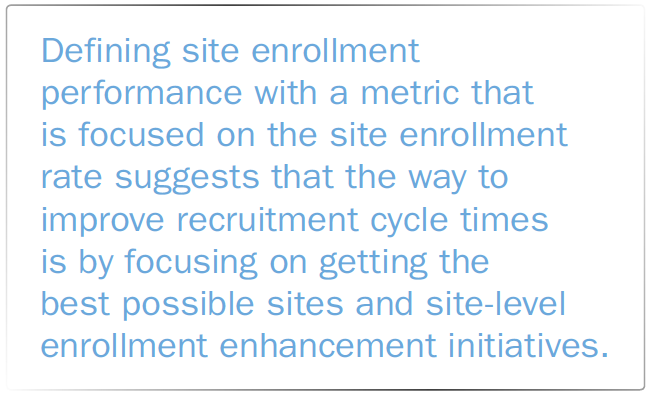
In this case study, as in any others that we have worked on, it has been demonstrated that site activation is an important driver in determining enrollment cycle time.3 There are operational limitations on the number of sites that can be activated in a defined time period, which restricts
the total number of patients that can be enrolled.
Another area of limitation is the question of how many sites can and should be deployed in a trial. The dominant thinking in our industry is still misguided on this point. Sponsors believe that if more sites are added to a trial, they will be able to proportionally reduce enrollment cycle time. The obvious fallacies for this thinking is that it implies that if we can add an infinite number of sites to a trial, then we can reduce the enrollment cycle time to near zero!
In our analysis, for clinical trials in any extensively studied disease indications, enrollment cycle time can always be minimized (the “sweet spot”) by deploying the adequate number of sites (PhESi internal analysis):
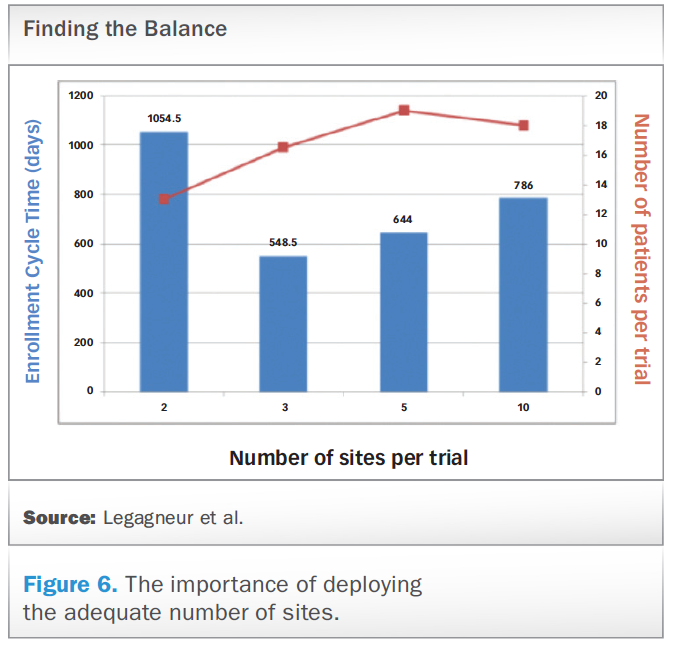
When we step too far out of the sweet spot, (for example, extrapolating the enrollment rate from a Phase II trial to a Phase III trial in the same development program) we can end up in a rescue situation (PhESi internal analysis):
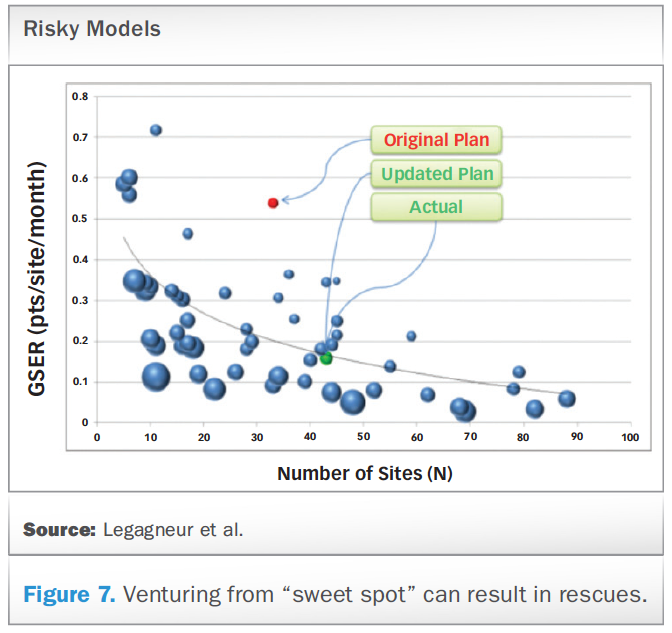
Objective feasibility gained from our analysis in this cancer trial also allowed the sponsor to improve its relationship with its contract research organization (CRO) partner. By incorporating improvement actions recommended by PhESi, the trial completed in the time frame we recommended.
Fortunately, the problems described in this article were identified in the planning phase, which allowed the sponsor to avoid potential conflict among key stakeholders, and prevented another possible rescue mission from being required.
Retrospectively, our plan was not perfect. We should have explicitly spelled out the nonperforming site issue. If we had incorporated nonperforming sites, we could have recommended to the team to deploy 150 sites, expecting 120 sites to enroll one or more patients. Having learned from this experience, nonperforming site analysis is now a regular component of our analysis.
Valerie Legagneur, Vice President, Clinical Operations, Odonate Therapeutics, LLC;Jonathan Peachey, Head of Client Services,PhESi, LLC;Karen Correa, PhD, Senior Director, Clinical Operations, Adare Pharmaceuticals, Inc.,Gen Li, PhD, Founder and CEO, PhESi, email: gen.li@phesi.com
Acknowledgement: Valerie Legagneur and Karen Correa were formerly employees of Pfizer, Inc. Adrian Li provided editing support.
References
1. Gen Li, 2015, Forecast Enrollment Rate in Clinical Trials. Applied Clinical Trials, Volume 35, Issue 3, pg 42-48
2. Gen Li, 2009. Finding the Sweet Spot. Pharm Exec. Published October 2, 2009. Available at: http://www.pharmexec.com/finding-sweet-spot?id=&pageID=1&sk=&date=
3. Gen Li, 2008. Site Activation: The Key to More Efficient Clinical Trials. Pharm Exec. Published December 12, 2008. Available at: http://www.pharmexec.com/site-activation-key-more-efficient-clinical-trials
4. Gen Li, 2009. SITE EFFECTIVENESS INDEX AND METHODS TO MEASURE AND IMPROVE OPERATIONAL EFFECTIVENESS IN CLINICAL TRIAL EXECUTION. U.S. patent publication No. 2010-0250273
5. Gen Li, 2014, METHODS OF FORECASTING ENROLLMENT RATE IN CLINICAL TRIALS, U.S. Serial No. 14/818,438, filed August 5, 2015, which claims the benefit of U.S. Serial No. 62/033,844

Improving Relationships and Diversifying the Site Selection Process
April 17th 2025In this episode of the Applied Clinical Trials Podcast, Liz Beatty, co-founder and chief strategy officer, Inato, discusses a number of topics around site engagement including community-based sites, the role of technology in improving site/sponsor relationships, how increased operational costs are impacting the industry, and more.
Behind the Buzz: Why Clinical Research Leaders Flock to SCOPE Summit
February 7th 2025In this episode, we meet with Micah Lieberman, Executive Conference Director for SCOPE Summit (Summit for Clinical Ops Executives) at Cambridge Innovation Institute. We will dive deep into the critical role of collaboration within the clinical research ecosystem. How do we bring together diverse stakeholders—sponsors, CROs, clinical trial tech innovators, suppliers, patients, sites, advocacy organizations, investors, and non-profits—to share best practices in trial design, program planning, innovation, and clinical operations? We’ll explore why it’s vital for thought leaders to step beyond their own organizations and learn from others, exchanging ideas that drive advancements in clinical research. Additionally, we’ll discuss the pivotal role of scientific conferences like SCOPE Summit in fostering these essential connections and collaborations, helping shape the future of clinical trials. Join us as we uncover how collective wisdom and cross-industry partnerships are transforming the landscape of clinical research.
FDA-Approved Gene Therapy Beqvez Shows Sustained Efficacy, Safety in Long-Term Hemophilia B Trial
April 17th 2025Beqvez (fidanacogene elaparvovec), an FDA-approved one-time gene therapy for hemophilia B, demonstrated sustained factor IX expression, low bleeding rates, and a favorable safety profile over long-term follow-up.